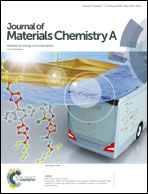The effects of SnS2 secondary phases on Cu2ZnSnS4 solar cells: a promising mechanical exfoliation method for its removal†
Abstract
The inhibition and removal of the SnS2 impurity phase in the kesterite Cu2ZnSnS4 (CZTS) layer is a major challenge for the improvement of CZTS solar cells; this impurity phase can critically damage device performance by forming a diode and a barrier for carrier collection. However, the formation and growth mechanism of SnS2 is incomplete and the common etching treatment with (NH4)2S is problematic because of its toxic characteristics. In this study, the formation and growth of large-size SnS2 sheets were observed to occur on the surface of the CZTS thin film via condensation during the cooling process. Sequently, a novel and benign peeling process was carried out using a sticky tape to effectively remove the SnS2 formed on the surface, resulting in a uniform CZTS thin film. A maximum efficiency of 4.3% of the oxides-derived CZTS device was obtained after this mechanical exfoliation, which is nearly eleven times that of the device without stripping. It was confirmed that this surface treatment is an effective and green way to remove the SnS2 impurity, which largely improved the performance of the CZTS device and may guide the preparation of pure phase CZTS thin films.



 Please wait while we load your content...
Please wait while we load your content...